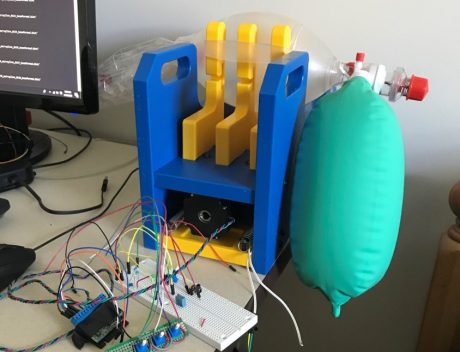
Paul A. Dayton, Ph.D.
AIMBE College of Fellows Class of 2018 For outstanding contributions to biomedical engineering in the areas of contrast-enhanced ultrasound imaging and ultrasound-targeted therapeutics.
Breaking Bacterial Barriers: New Strategy Improves Treatment of Chronic Wound Infections
Via Scitech Daily | July 26, 2023Scientists have developed a new strategy to improve the delivery of drugs to chronic wound infections.
Chronic wounds, which are persistent open sores or damaged tissues that do not heal correctly, pose a significant challenge to treat because of bacterial infections such as Staphylococcus aureus, or S. aureus. This situation is further complicated when these bacteria are resistant to antibiotics, such as methicillin-resistant S. aureus (MRSA), a primary source of severe infections in hospital environments.
To protect itself from the human immune system and other potential threats, S. aureus can aggregate to form a slippery and slimy shield known as a biofilm. The biofilm barrier is so thick that neither immune cells nor antibiotics can penetrate through and neutralize the harmful bacteria… Continue reading.
New Tool Uses Ultrasound ‘Tornado’ to Break Down Blood Clots
Via NCSU | January 23, 2023Researchers have developed a new tool and technique that uses “vortex ultrasound” – a sort of ultrasonic tornado – to break down blood clots in the brain. The new approach worked more quickly than existing techniques to eliminate clots formed in an in vitro model of cerebral venous sinus thrombosis (CVST).
“Our previous work looked at various techniques that use ultrasound to eliminate blood clots using what are essentially forward-facing waves,” says Xiaoning Jiang, co-corresponding author of a paper on the work. “Our new work uses vortex ultrasound, where the ultrasound waves have a helical wavefront… Continue reading.
Biomedical engineering researchers target glioblastoma recurrence
Via NCSU | May 12, 2021Glioblastoma is one of the most aggressive forms of cancer, affecting the brain and spine and often recurring despite treatment. With funding from the North Carolina Translational and Clinical Sciences (NC TraCS) Institute, a team of researchers at NC State’s and UNC-Chapel Hill’s Joint Department of Biomedical Engineering gathered crucial preliminary data about glioblastoma recurrence, enabling further research.
The NC TraCS Institute is a NIH grant funded institute based out of University of North Carolina at Chapel Hill’s School of Medicine and partners with NC State, North Carolina Agricultural and Technical State University and RTI International. NC TraCS offers targeted, comprehensive and interdisciplinary solutions to investigators in the area of clinical and translational science. Biomedical engineering assistant professor Yevgeny Brudno, based at NC State, and professor Paul Dayton, based at UNC-Chapel Hill, conducted the study “Targeting Glioblastoma Recurrence through Focused Ultrasound-Enabled Refillable Drug Depots… Continue reading.
Nanodroplets and ultrasound ‘drills’ prove effective at tackling tough blood clots
Via Phys.org | January 7, 2021Engineering researchers have developed a new technique for eliminating particularly tough blood clots, using engineered nanodroplets and an ultrasound “drill” to break up the clots from the inside out. The technique has not yet gone through clinical testing. In vitro testing has shown promising results.
Specifically, the new approach is designed to treat retracted blood clots, which form over extended periods of time and are especially dense. These clots are particularly difficult to treat because they are less porous than other clots, making it hard for drugs that dissolve blood clots to penetrate into the clot… Continue reading.
What they’re trained for
Via NC State University | May 11, 2020Biomedical engineers at UNC-Chapel Hill and NC State respond to COVID-19 by teaming to speed the development of an emergency ventilator

A prototype of the CaRE-Vent emergency ventilator, which can be
manufactured with six hours of skilled labor for less than $1,000 per unit
(Photo by UNC-Chapel Hill)
Biomedical engineering student Kathlyne Bautista always knew that her coursework and training would set her on a path to make a life-changing difference for people. But before the coronavirus pandemic, she didn’t realize just how soon that opportunity would arrive.
Bautista is part of the Carolina Respiratory Emergency – Ventilator (CaRE-Vent) team led by Dr. Yueh Lee, MD, an associate professor at the University of North Carolina at Chapel Hill. His research team is sprinting to design and prototype an open-source ventilator in a matter of weeks that has the potential to help fill a critical equipment gap caused by a projected spike in COVID-19 patients. The group is designing the ventilator so that it could be manufactured quickly and inexpensively – at less than $1,000 and with only six hours of skilled labor per unit.
And even in the best-case scenario – where the COVID-19 curve flattens to the point that the device is never needed for patients – the team’s efforts are advancing knowledge in the biomedical design community about the best way to create emergency ventilators in the future… Continue reading.
BME Prof Paul Dayton receives 2019 W.R. Kenan Distinguished Professor Appointment
Via UNC and NC State | September 18, 2019 This week the Office of the Executive Vice Chancellor and Provost announced that BME Professor Paul Dayton is receiving a W.R. Kenan, Jr. Distinguished Professor appointment. Professor Dayton, a biomedical ultrasound engineer, is also Associate Chair at the UNC/ NCSU Joint Department of Biomedical Engineering. Moreover, he is Professor in the UNC Eshelman School of Pharmacy and an Adjunct Professor of Radiology. Dr. Dayton is widely published and cited for his innovative work using ultrasound and microbubble contrast agents for biomedical applications… Continue reading.
This week the Office of the Executive Vice Chancellor and Provost announced that BME Professor Paul Dayton is receiving a W.R. Kenan, Jr. Distinguished Professor appointment. Professor Dayton, a biomedical ultrasound engineer, is also Associate Chair at the UNC/ NCSU Joint Department of Biomedical Engineering. Moreover, he is Professor in the UNC Eshelman School of Pharmacy and an Adjunct Professor of Radiology. Dr. Dayton is widely published and cited for his innovative work using ultrasound and microbubble contrast agents for biomedical applications… Continue reading.
Novel Approach to Ultrasound Raises Possibility of New Medical Applications
Via NC State News | September 17, 2019A new ultrasound technique provides a non-invasive way of assessing bone structure on the microscale. Researchers hope to fine-tune the technique for use in assessing osteoporosis risk and treatment.
Researchers have also demonstrated that a variation of the same technique can distinguish between tumors and healthy tissue in a study using laboratory rats… Continue reading.
Dr. Paul Dayton Inducted into Medical and Biological Engineering Elite
Via AIMBE | April 10, 2018WASHINGTON, D.C.—The American Institute for Medical and Biological Engineering (AIMBE) has announced the induction of Paul A. Dayton, Ph.D., Professor, Joint Department of Biomedical Engineering, University of North Carolina at Chapel Hill, to its College of Fellows. Dr. Dayton was nominated, reviewed, and elected by peers and members of the College of Fellows for outstanding contributions to biomedical engineering in the areas of contrast-enhanced ultrasound imaging and ultrasound-targeted therapeutics.
 AIMBE
AIMBE
